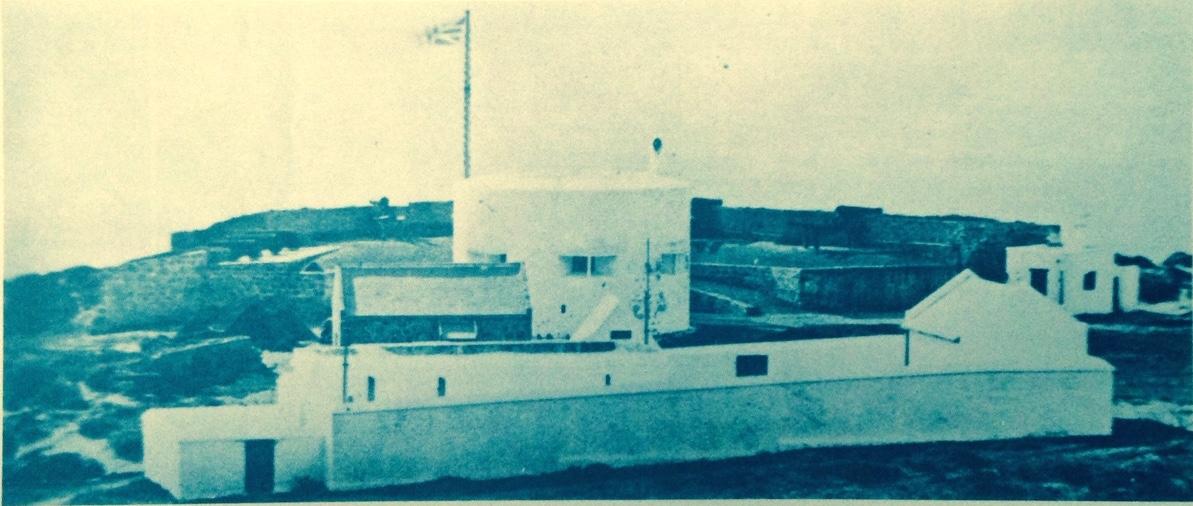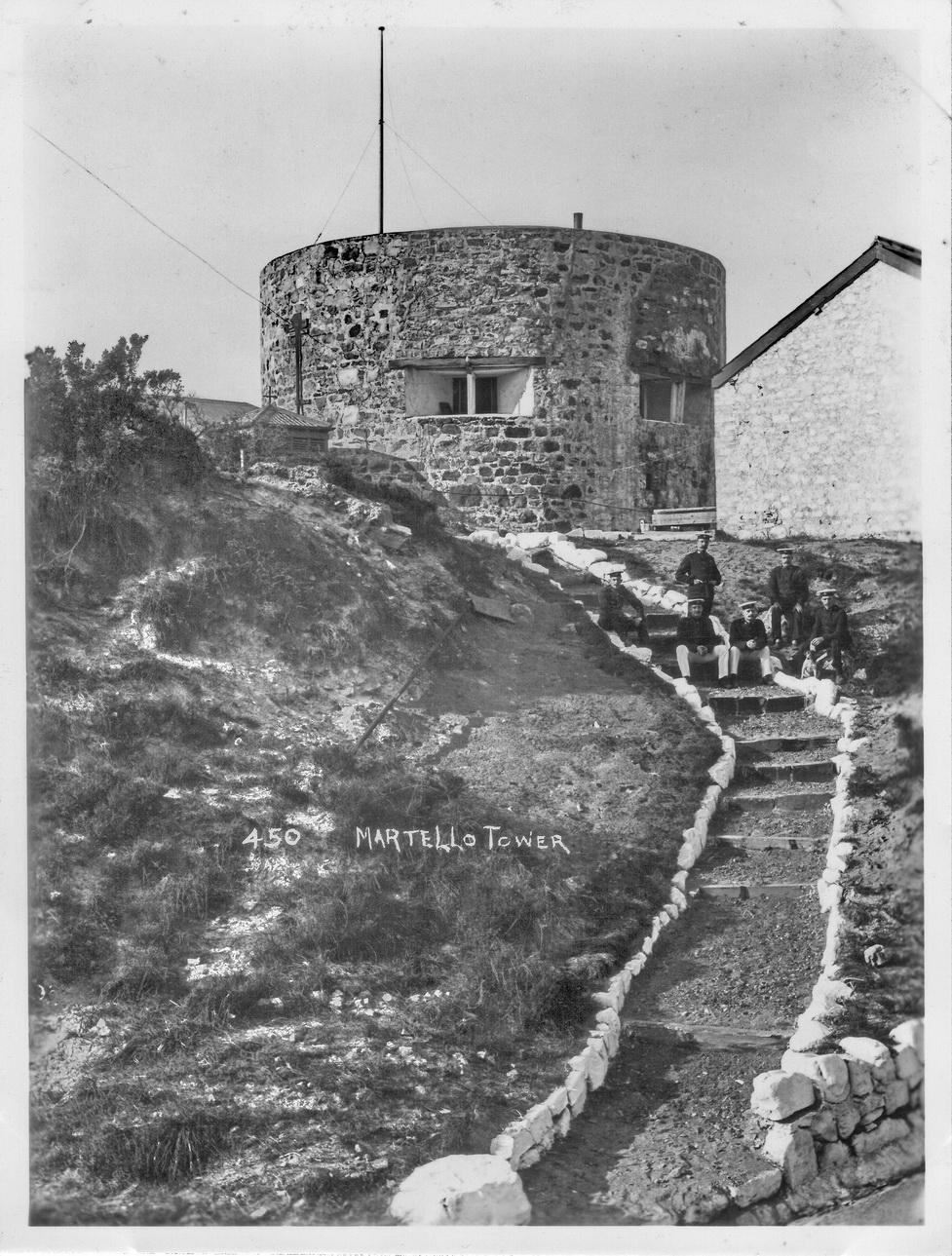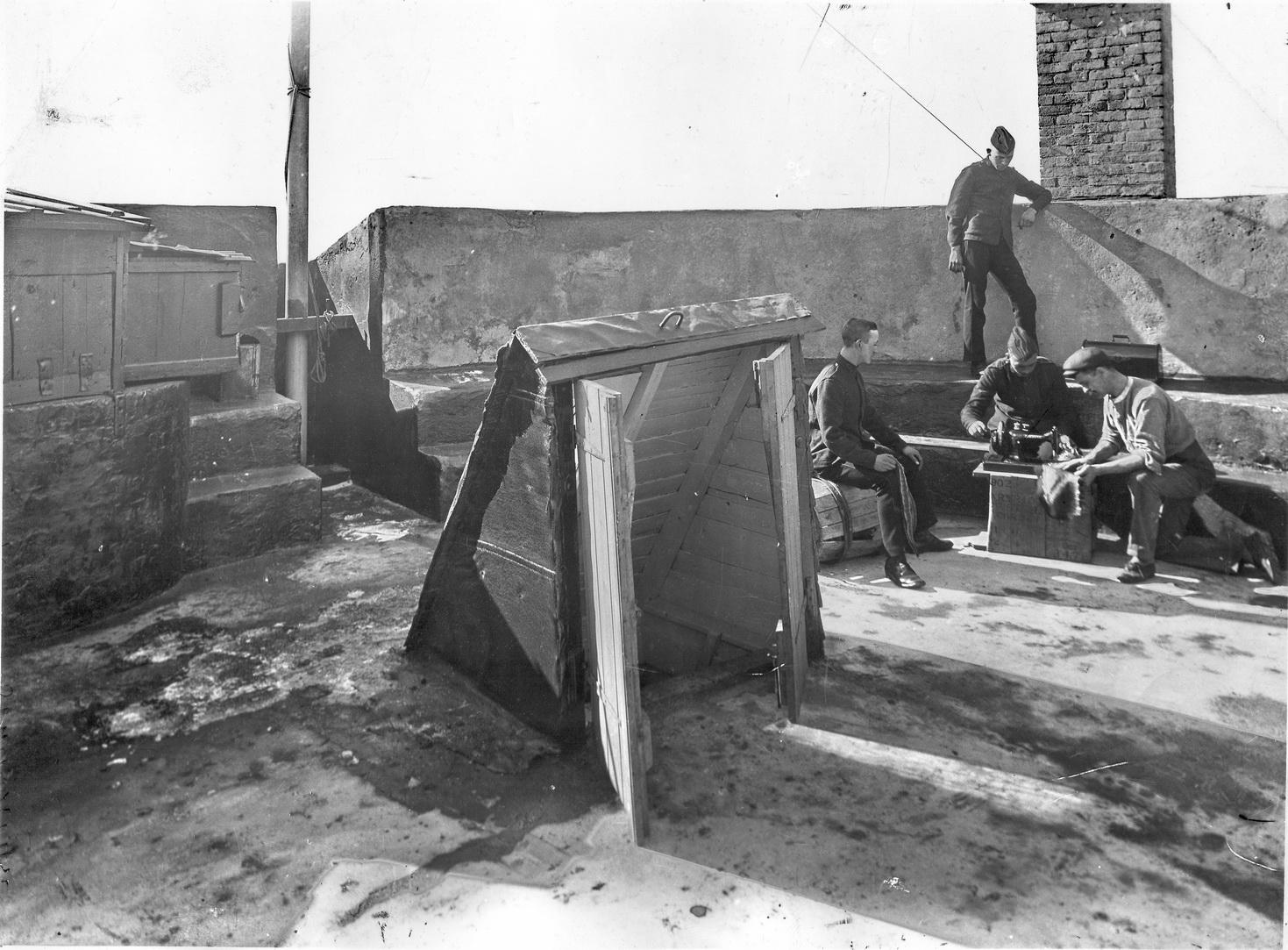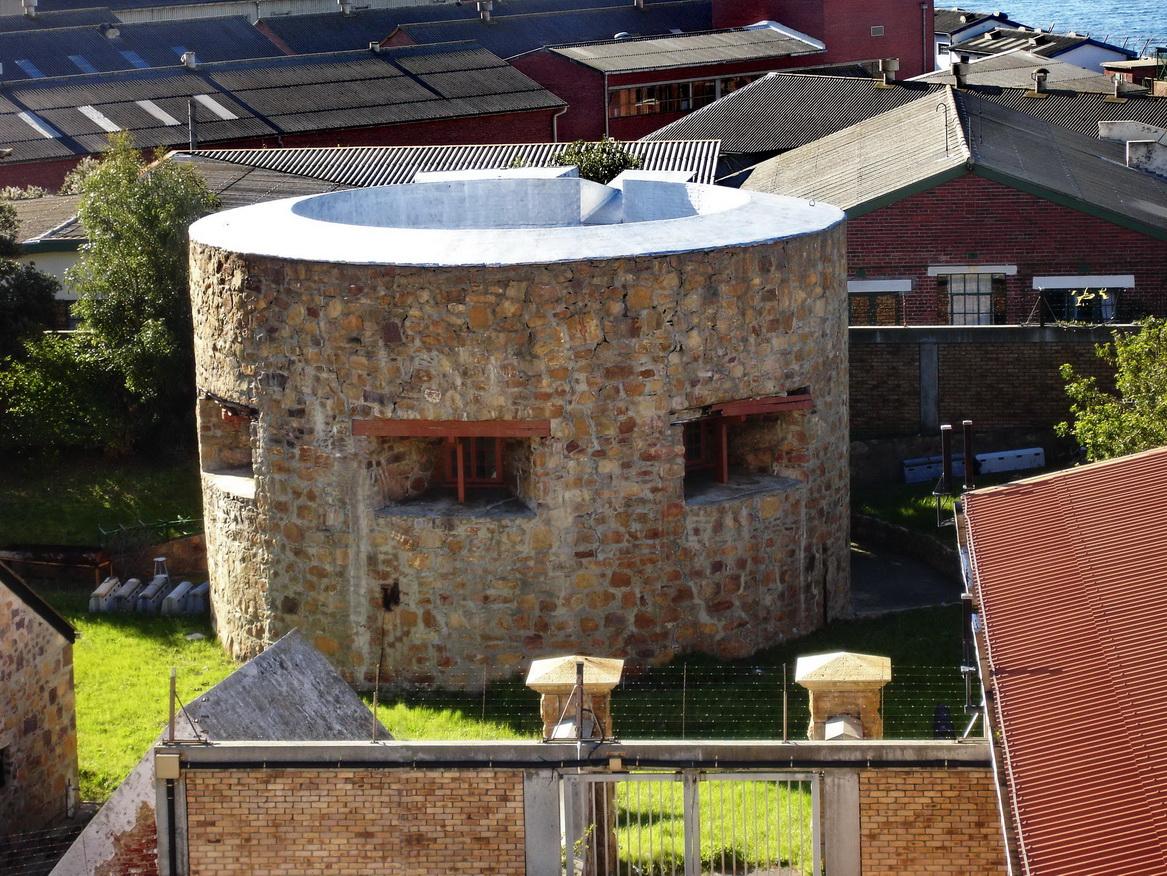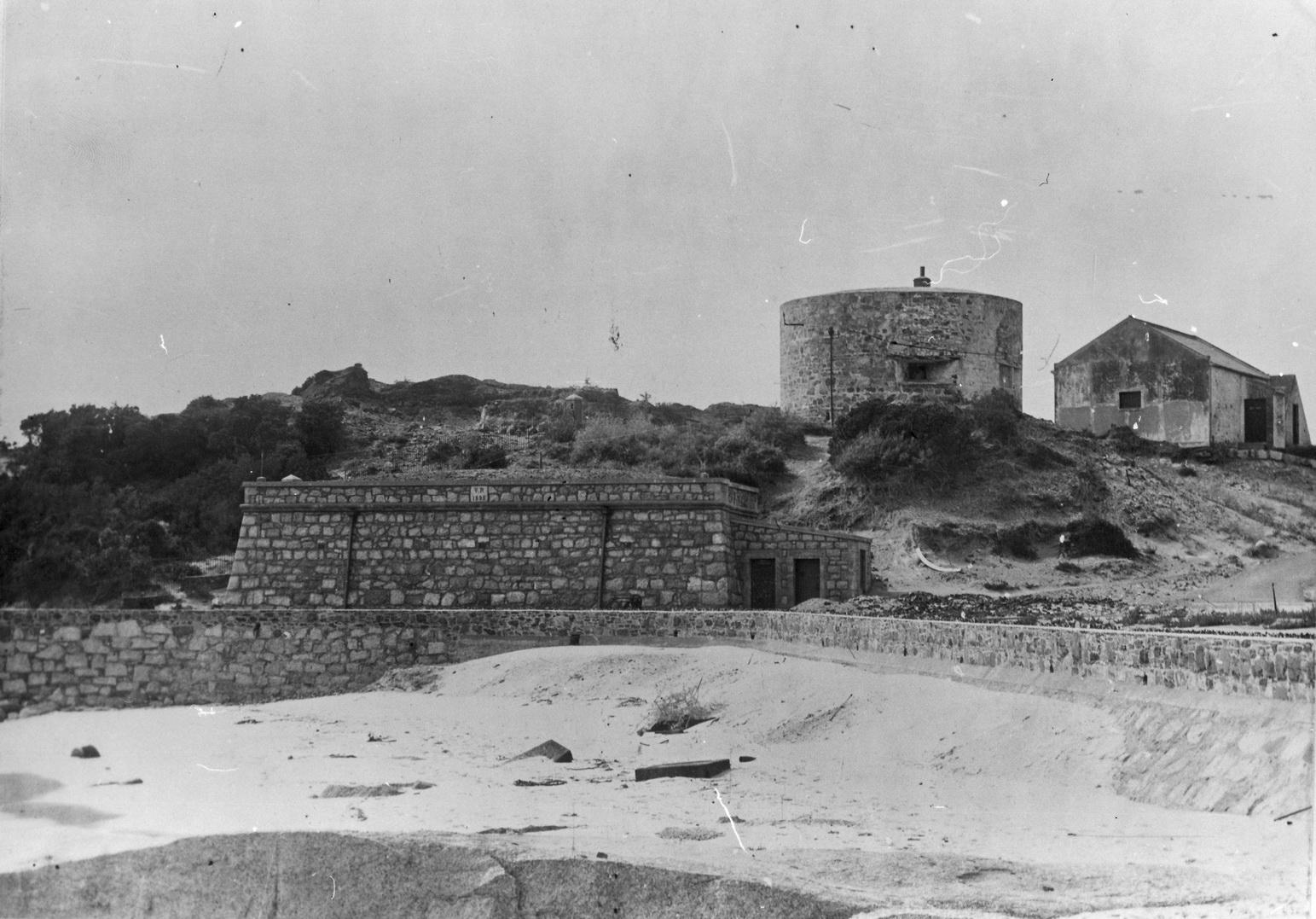
Disclaimer: Any views expressed by individuals and organisations are their own and do not in any way represent the views of The Heritage Portal. If you find any mistakes or historical inaccuracies, please contact the editor.
The following article on the history and restoration of the landmark Martello tower in Simon's Town appeared in the September 1973 edition of Bulletin. Thank you to David Erickson from the Simon's Town Historical Society for providing many of the museum photographs. See comments section for more recent details on the Tower.
In the year 1794, during the Napoleonic War, the British Fleet was engaged in blockading the French port of Toulon. A requirement arose to establish a safe anchorage in the Bay of Fiorenzo, Corsica, for use by the Fleet. However, the shores of the Bay were well fortified. On the 8th February two British ships, Fortitude (74 guns) and Juno (32 guns) arrived at the entrance of the Bay intent on destroying these fortifications. On the Western extremity of the Bay, on Cape Mortella stood a large circular tower armed with two guns and a garrison of two grenadiers and twenty seamen.
During the attack of some two and a half hours the garrison put up such a spirited defence that the ships had to withdraw, having suffered 6 dead, and 56 wounded, as well as being severely damaged. That same evening a body of troops under the command of Major General David Dundas was landed and the following morning an attack was launched from the landward side and victory was only gained when the attacking troops contrived to smoke out the gallant defenders by setting fire to faggots piled against the tower.
This remarkable achievement of such a small number of men with only two medium sized guns, in repelling an attack by two heavily armed warships, immediately established a reputation out of all proportion to its importance, for this type of fortification. Admiral Sir John Jervis, aboard H.M.S. Victory wrote: “…and I hope to see such works erected… on every part of the Coast likely for an enemy to make a descent on.” A model of this tower was made in the same year and is now preserved in the Military College at Woolwich and is inscribed: Model of a Martello Tower in the Isle of Corsica sent to the Repository by Admiral Sir J. Jervis.
This is the first time the name “Martello” appears, a corruption of Cape Mortello. When the British occupied the Cape in 1795, they did so to forestall any similar French action. The occupying troops were under the command of Major General James Craig, who was appointed Acting Governor of the Cape and who set about improving the coastal fortification of Simon’s Bay. He constructed, as part of these improvements, a large powder magazine capable of containing 980 barrels of gunpowder (being the reserve ammunition for the Royal Naval Ships), in the near vicinity of the Southern Battery named “Boetselaar”. To protect this magazine as well as the rear of the Battery he constructed the present Tower - Simon’s Town’s Martello Tower - completed in 1796.
The Martello Tower, Simon's Town, from a photograph taken in 1868. Because it was used as a navigational mark for ships entering Simon's Bay, the tower was painted white in 1843 (South African Navy)
A few short years later, three British Officers found themselves together and responsible for the defences of England. Admiral Elphinstone, who commanded the Fleet involved in the occupation of the Cape in 1795, now Lord Keith, was appointed in Command of all Naval Forces in the North Sea and English Channel.
Lieutenant General Francis Dundas, returning from the Cape, was appointed in command of all troops south of the River Thames and Lieutenant General Sir James Craig, who built this Tower, was appointed in command of all troops north of the River Thames.
These commanders faced the problem of defending a long stretch of coastline with meagre forces and their thoughts may have turned to the engagement some ten years before in Corsica, as well as their tour of duty in the Cape, for soon thereafter one hundred and three large and more refined Martello Towers were erected by the Royal Engineers along the coastline.
Construction of the Tower
This Tower is a study in the use of locally available material of the time. Being built of local sandstone, the tower is circular with an overall diameter of 12,57m and is 7,85m high. The wall is a uniform 1,83m thick and is perpendicular without projections of any kind with the exception of the timber structure over the doorway.
In the centre of the circular structure there is a pillar 1,14m square extending from the ground floor to the underside of the roof boarding. This pillar, built of stone set in lime mortar, supports the first floor and the roof as well as forming the base for any gun that may have to be mounted on the roof.
The entrance, on the ground floor, consists of two pairs of double doors constructed of two layers of 2,5cm thick Oak boards spiked at right angles to each other. Each door was hung on a pair of iron hinges driven into the frame and built into the opening. The outer pair of doors are smaller than the inner pair. The stonework over the doorway is supported by a massive Oregon Pine lintel which was adzed to the circular shape of the building.
For ventilation on the ground floor there are three cranked vents situated 1,20m above the floor level. These vents were cranked to prevent anyone from firing a rifle into the building through the vents. The floor itself is of compacted sand and stone which was later covered with a layer of concrete.
The first floor was constructed of 5cm thick caulked Greenhart and Yellowwood boards in varying widths up to 41cm in random lengths. The boards were supported on 20cm X 15cm bearers resting on 20cm x 15cm Yellowwood posts, which were roughly smoothed off with a shipwright’s adze. Leading from the group floor to the first floor there was a curved staircase built of Teak stringers with Oregon Pine treads. Protecting the stairwell on the garrison floor there was a baluster of Oregon Pine.
Supported on the timber structure of the garrison floor, assisted by two built in granite corbels, visible from the basement floor only, was a double layer of slate upon which was built a fireplace. This fireplace was built of a very soft yellow clay brick and lime mortar with the flue originally penetrating the roof structure only.
Openings on the first floor consist of three large embrazures, which cover all the approaches to the tower from the landward side. These embrazures taper from 312cm wide x 145cm high on the outer face to 93 cm wide x 89 cm high on the inner face. The stonework on the sides on the sill, which was set sloping outwards, was set and bedded in lime mortar and the stonework above was supported on very large timber beams resting on a lining of 5cm thick Teak boards which were adzed and dowelled together for additional strength.
Martello Tower circa 1900 (Simon's Town Museum)
The flat roof was constructed of timber as described for the first floor, waterproofed by setting one layer of bricks on the boarding and covered them with a 2,5cm thick layer of asphalt which was laid sloping towards the single opening in the parapet. Again the boarding was let into the wall and used as a platform to erect the parapet wall as well as the concentric steps which were supported solely by the timber of the roof. The two steps were built of stone, the lower step being 30cm wide; the second step was 38cm above the lower step and 61cm wide, with the top of the upper step 1,23m below the top of the parapet wall. The sides and tops of the steps as well as the parapet wall were plastered and set sloping to afford a protected firing point for the troops stationed on the roof. Access to the roof was by means of a ship’s ladder (constructed of Oregon to which was fitted a Teak handrail) leading from the garrison floor to a 1,07 x 1,07m hatchway in the roof. A hatchway of this nature would not be weatherproof and subsequently a whaleback of Oregon Pine, fitted with a pair of dwarf doors, was erected over the companionway.
Top of the Martello Tower - Circa 1900 (Simon's Town Museum)
An opening 1,00m x 1,70m high led through the parapet wall to give access to a timber gantry structure situated directly above the doorway. This gantry was 1,45m wide x 1,23m projection according to available information, although no trace of the original structure remains. The sides as well as the floor have 5cm wide x 61cm long observation openings situated in the centre of each panel.
Two metres to the south of the opening to the gantry, a flagpole, of which no trace other than an iron collar exists, was secured and embedded in the stone wall. This flagpole would have been approximately 6 metres in length supported by stays and having, according to old photographs, triangular fillets spiked to it to enable a lookout to climb the mast for a better view.
The Life of the Tower
For more than a century the Tower figured as a prominent feature of the Simon’s Town landscape, and although no record has been found that any guns were ever actually mounted on the tower, it would easily have been armed by hoisting a gun onto the roof.
The armament of the Battery was changed from time to time, with the advent of more modern guns whilst the Tower protected the landward side and the magazine, until the arrival of the rifled guns firing explosive shells which rendered the smooth bore guns completely obsolete. The superior range and accuracy of the rifled guns could be enhanced by mounting them at a greater elevation above sea-level and therefore no attempt was made to modify the South Battery to accommodate these guns and a new emplacement was erected further up the slope of the mountain about a mile to the South.
With this new development, the old battery was abandoned and the Tower was used to provide living accommodation for the development of Royal Marines employed as guards for the powder magazine and ammunition stores in the vicinity. This guard detachment became redundant at the turn of the century when the whole area was enclosed for the construction of the new dockyard, and the Tower was left vacant and derelict.
In the course of time the structure deteriorated and eventually started to fall to ruin. The stonework collapsed in two places over the window embrasures and started to bulge dangerously over the third. Dampness penetrated into the walls and attacked the woodwork and the mortar in the building causing large stones to break loose and fall on the rotten woodwork, thereby accelerating the decay of the structure. Years of exposure had disintegrated some of the bricks on the roof resulting in collapse of the beams and permitting more damp to enter the building. A fire had destroyed part of the first floor and the termite-ridden plaster began to peel off at the walls.
The Restoration
The active interest in the restoration of the Tower was started by the late Mr W. Runciman, then Mayor of Simon's Town. Having failed to arouse the interest among the higher authorities he made an appeal to the general public in a letter to the ‘The Cape Times’ which was published on 30th April, 1936, after his death.
During the following twenty years, spasmodic attempts to effect this restoration were made by various prominent citizens of Simon’s Town. This movement received a tremendous boost with the formation of the Simon’s Town Historical Society in 1960, which was able to speak with a much more authoritative voice. It received much sympathy from the Naval authorities, but little else, since funds for defence purposes could not be spent on obsolete fortifications of no military value. The Historical Monuments Commission were also very sympathetic but came to the conclusion that the Tower could not be declared a historical monument, until it had been put in a proper state of repair. This resulted in another public appeal published in ‘The Cape Argus’ on the 15th August 1963.
The Historical Society instituted a fundraising programme among its members but, although the response was evidently encouraging, it rapidly became very evident that such a project was beyond the means of an individual Society.
However, in 1966 the South African Defence Force at Defence Force Headquarters Pretoria, created a Museum Section whose staff showed interest in the Tower. This culminated in the happy decision to restore the Tower with the object of housing a museum. The Tower was proclaimed a National Monument in 1972.
The restoration of the building commenced on the 27th August , 1970 undertaken by the Works Branch of the S.A. Navy, who after salvaging the more valuable components of the building demolished nearly 300 tons of stonework to install a heavily reinforced concrete beam in the wall to strengthen the structure. The original stone was salvaged, cleared of all mortar and re-used. The timber components of the building were reconstructed and a new gantry was replaced in the original position over the doorway. All the locks, hinges etc, no trace of the original having been found, were copied or removed from the other old buildings dating from the same period, and finally the building was topped with a new flagpole in its original position. As a building the Tower obviously has no claim to beauty nor has it any particular merit as a piece of architecture for it is a simple building. Yet let not its simple dignity deceive, for a good case can be made that this Martello Tower may be the oldest surviving structure built by the British in South Africa, having been built only four months after the Capitulation on the 16th September 1795.
In addition it may well be the oldest surviving Corsican-pattern tower in the world; its only rival in age may be the Prince of Wales Tower in Halifax, Nova Scotia which was begun in 1796, being a very much larger and more sophisticated structure.
A more recent photo of the Martello Tower (private collection of David Erickson)
Opening the Martello Tower
On May 2, 1973, the Martello Tower, the oldest British Building in South Africa and the oldest existing defence force structure of its kind in the world, became a museum of the South African Defence Force (S.A.D.F).
Adm. H. H. Biermann, S.S.S.A., O.B.E., Chief of the Defence Force, officially opened the museum and outlined its importance to the S.A.D.F., which has restored the tower. “We honour the founders of Simon's Town as a naval base and attempt to illustrate the town’s place in history. To be ignorant of or ignore one’s history is to be a traveller to nowhere,” he said.
Adm Biermann traced the history of the tower in the perspective of the strategic importance of the Southern extremity of Africa since the 15th century. He told guests that the tower also served as evidence of the British contribution to our military history. “I would like to take this opportunity to express the appreciation of the S.A.D.F. to the British Navy for the important part it played in the establishment and training of the S.A. Navy in the past. May this fruitful cooperation continue in the future to our mutual advantage.
Comments will load below. If for any reason none appear click here for some troubleshooting tips. If you would like to post a comment and need instructions click here.

